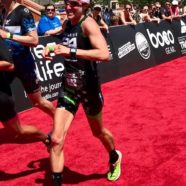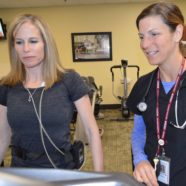Sarah Barber: 2018 Ironman St. George 70.3
Our teammate and fearless track star offers a glimpse at the Half Ironman experience: Anyone considering a half-ironman triathlon should be forewarned: the race is a logistical nightmare in every way. In other words, the training is the easy part. I was reminded of this fact the day before the 2018 Ironman St. George 70.3. The point-to-point course design meant that most of Friday was consumed with gear drops and familiarization at two different transition zones miles and miles apart. However, I somehow managed to get everything done without completely exhausting myself. Race morning arrived without any fanfare, and my headspace was good. Unfortunately, things went south immediately after the shuttle bus dumped me and a bunch of nerved-up triathletes at the shore of Sand Hollow Reservoir. I went straight into T1 to visit my bike, which had spent the night there without me, as my first priority was to air up the tires. The valve extender on my deep-dish carbon wheels had never been finicky in the past, but for whatever reason, I could not get the valve open enough to add air—or let air out, for that matter. One of my favorite bike experts (and owner of Tri Town Boise) was on scene to assist, but he was as frustrated as I was. Brainstorming solutions had me running back and forth to tech support, borrowing a different pump, then Bogarting a spare tube. At some point, we learned that my wheel wasn’t a clincher after all, but a tubular, and therefore impossible to replace on the spot. For a moment, it appeared that I might not even be able to participate in the race, which would have felt almost tragic after devoting the last few months of my life to preparing for it. Good friend and local pro, Erin Green, pointed me toward a woman named Paula, the pro athlete liaison, for emergency assistance. I’m ashamed to admit that I didn’t know until days later that “Paula” was Paula Newby-Fraser, a well-known and highly successful professional triathlete in her day. Anyway, she helped me find a wheel to borrow—a random road bike wheel with a rotor for disc brakes. By some miracle, it fit on my bike without any issue and worked fine with my traditional caliper brakes. My first crisis was averted with 15 minutes till the start of the race.. During the entire 45 minutes I had spent running all over T1, my second poop of the morning was getting overcooked. In other words, I had to drop a deuce like nobody’s business, and at this point the Porta-Potty lines seemed to go on for miles. Nonetheless, I took a place at the end of the nearest line and spent my wait time peeling on my wetsuit, inch by inch. I landed on a toilet with less than 10 minutes remaining before the start of the race, and was instantly relieved. Until I discovered that there was no toilet paper. Rummaging through my plastic sack of warm-up clothing, I thoughtfully considered each item. Lululemmon pants? NO way! UpCycle hoodie? Shoot, I really liked that thing… And then I found it: a black wool hat with the word “BACARDI” in bold white caps on the front. It seemed a fitting end for a freebie I’d picked up at an event in Las Vegas years ago. And then, to the shore of Sand Hollow Reservoir I went. I couldn’t help but think how lucky I was to be able to do this race, despite the issues that had cropped up to sabotage me this morning. The...
Read MoreHow to Dress For Winter
Good stuff found on the NASM blog, and so very relevant to today’s weather in Boise. Enjoy, Betties and Bettie fans! By Sam Hutchison CES, CPT, NASM-CPT The seasons have changed, and for some of us it means below freezing temperatures and snow on the ground—not the most ideal conditions for exercising and physical activity. Fortunately, you don’t have to limit yourself to treadmills, ellipticals and recumbent bikes, exercising outdoors is still a plausible option with some foresight and a plan of action. If you dress properly and follow some easy strategies, you can survive the frigid forefront and exercise at your own discretion. As humans, our bodies aren’t accustomed to cold climates and take longer to adapt to the cold compared to warmer environments. Biologically humans weren’t designed to live in cold climates; humans lack heavy fur coats and a thick lining like many animals living in colder climates thus making heat production and insulation more difficult. Wearing protective layers is essential to preventing not only a decline in exercise performance but more serious issues such as hypothermia and frostbite. Effect on Performance Exercising in cold climates can have inhibitory effects on both cardiorespiratory and strength performance. When exposed to cold environments, the body reduces blood flow to the skin and extremities via vasoconstriction to prevent heat loss and maintain the temperature of the body’s core and vital organs. Due to vasoconstriction and blood cooling, aerobic energy components such as fat and oxygen aren’t as efficiently transported to the muscles for energy production (1). Fuel sources that are typically used for higher intensity training, like muscle glycogen, begin to be used as a replacement, leaving less fuel for later and an earlier onset of fatigue results (2). When muscle temperatures fall below a certain point, the time for muscles to contract and the amount of muscles recruited (motor unit recruitment) for an activity is compromised (3). This limits the amount of force and power typically seen at more favorable temperatures. If not taken seriously, a decline in performance can lead to frustration and possible injury. Before You Step Outside Here are some tips you’ll want to consider implementing before stepping outside to exercise or train. It may not seem like much, but following these tips can make your workouts more enjoyable and ultimately safer. 1. Wear layers: It’s difficult to judge just what to wear when planning on exercising outdoors in the cold. Wearing layers allows you to easily adjust and remove layers of extra insulation as your temperature increases. 2. Remove wet clothing: Water conducts heat much faster than air, so your body loses heat more quickly when clothes are wet. Remove wet clothing to stay properly insulated. 3. Be selective about fabrics: Keeping the skin dry is one of the first layers of defense against the cold. Use a moisture wicking fabric next to the skin; synthetic fabrics and wool dry more quickly than their cotton counterpart. Additional heat can also be lost through wind chill, so make use of wind breaking material on outer layers. 4. Hats, footwear and gloves: As stated earlier, it is important to prevent heat loss and make sure there is optimal blood flow to vital organs and working muscles. The hands, feet, and especially the head are vulnerable areas for heat loss and should be kept insulated. A pair of running gloves, insulating socks, training shoes and a wool/fleece hat can help prevent heat loss. 5. Hydrate, Hydrate, Hydrate: Just like in the heat, it is important to hydrate when cold. You might not realize that you can become dehydrated...
Read MoreBlue Lake Duathlons
Looks like 31 😉 Run! Olympic Duathlon Finish #Bettieup Two Betties on the...
Read MoreSawtooth Relay
The Betties had two teams on the course, but only have photos from one of the teams here. The other photos are coming soon! Pictured here: Shea, Gabby, Bridget, Melinda, Angenie and Gretchen take on the 61 mile relay (in that order). In the end, the team took the Women’s Open title once again! Great work to all and thanks for all of the fun times 🙂 Pre race team selfie Teammate hand-up Awkward Exchange Gretchen on Galena All smiles from Shea Em stays the course Gabby and Bridget A meeting of the Bettie Teams Women’s Open...
Read MoreHeart & Sole: Survivor’s Perspective on SCAD
Cynthia Mauzerall was planing to race the USATF Cross Country Championships with the Boise Betties’ masters team. Just a month before the race, she suffered a heart attack. It was an incredibly scary time for our team. Here Cynthia shares her perspective on the events immediately following the event. When I woke up, I saw faces staring at me-friendly, helpful, concerned, surprised. Family members were tearing up and I had no idea why. The only words I could think to say were, “hi” and “what am I doing here?” My husband was told he would be sharing the details with me over and over again until my memory got stronger. When I was informed that I had suffered a Spontaneous Coronary Artery Dissection (SCAD), I wasn’t sure how to wrap my arms around that. Frankly, I thought maybe they made a mistake. I asked myself, “Are they overreacting?” The look on the faces of the team of doctors suggested it was true. Amongst this team of white lab coats was one of my best friends since age 15. Certainly she will tell me what’s what. Dr. Jen (formally known as Dr. Jennifer Anderson) was calm and composed and yet seemed to empathize with how odd all this was to me. She likely knew I had to grasp that this was serious enough that I would not be heading out the door for a run any time soon. Once the doctors left the room, I searched for evidence. What are all these tubes, catheters, and scars? Family explained that a stent was placed over the dissected artery. I began to feel pain in my chest and ribs. They told me that was CPR that was conducted by 2 everyday heroes at the gym- a retired paramedic and a physical therapist. Slowly I ventured out of detective mode into one of Gratitude. I was grateful for Family and for amazing medical team that despite their current unassuming demeanor had to respond at lightning speed with limited information when I arrived at the ER. I was grateful for those who stepped up and did CPR knowing that it might not make a difference. The theme of gratitude has been on my mind continually- much because my story was filled with events that now seem rather miraculous. However, I am also grateful for mindfulness and science. Dr. Jen and her team keep abreast of advancements and case studies in Cardiology. In fact, Dr. Jen has been known to stash The New England Journal of Medicine in her bathroom for “easy reading”. A new gratefulness has emerged for curiosity and mindfulness. Dr. Jen has reiterated that we are experts on what are bodies are communicating to us. We need to listen, to be curious, to ask questions. I had ben slowing down substantially on my runs and workouts but felt foolish mentioning it to anyone. I felt lucky to be as active as I am at 42. I could have simply said, “Maybe this is nothing, but….” We don’t have to be MDs to be mindful of our bodies, and what they communicate to us. There are folks out there like Dr. Jen whose passion is to understand what the symptoms mean, we just have to vocalize those...
Read More






